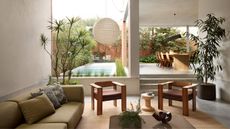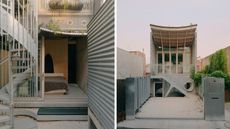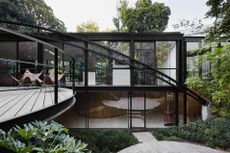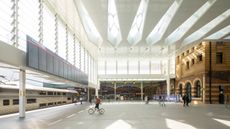Out of office: we’re disconnecting at Branch Architecture Studio’s lakeside retreat

A couple of hours' drive from Melbourne is a modest building that avoids technology. Cantilevered over a lake at Balnarring, on the tip of Victoria’s Mornington Peninsula, this 60 sq m pavilion was designed as a retreat, separate from the main house. 'Our client wanted her own space, a place that almost felt part of the lake and these majestic surrounds,' says architect Nick Russo, co-director of Branch Studio Architects.
Constructed in timber, charcoal rammed earth, concrete and glass, the Balnarring house features one large, dramatic picture window to the lakeside and carefully articulated slot windows from the open-plan kitchen, dining room and living area. Only a curtain divides the main bedroom and the living area, and the bathroom features no windows – simply a glass roof that doubles as a skylight.

The little house is lined with plywood inside and glazing opens the interior up to the lake view
'When you’re in the bathroom, you feel like you are outside,' says Russo. A similar feeling is created when visitors lie on the built-in concrete daybed in the living area, just 150 millimetres above the water level of the lake.
From the outset, the brief for this retreat was for a simple ‘shack-like’ experience, one that eschews technology. The kitchen, for example, is a simple plywood-lined alcove with a brass sink inserted. The dining table folds out of a cavity in the wall and is erected when needed – as is the bed, which can be placed in a cupboard. And rather than add superfluous detail, the finishes are simple.
A limited palette of plywood walls, folded ceilings and concrete floors completes the interior. 'Our brief was for a "non-prescriptive" space,' says Russo, 'almost an empty shell that could either appear "dormant" or "activated". It was about slowing down from a hectic pace of life and removing yourself from technology.'

The retreat is located in Balnarring, on the tip of Victoria’s Mornington Peninsula in Australia

The glazing connects residents with the landscape

An ingenious system of invisible storage allows the space to unfold. The dining table simply folds out of a cavity in the wall and is erected when needed – as is the bed, which can be placed in a cupboard

Alcoves open up in the walls between built-in storage

The bathroom’s glass roof connects the inhabitant with the natural surroundings

Exposed brass pipes communicate the simplicity and functionality of the house

The retreat cantilevers over the lake. When the owners lie on the built-in concrete daybed in the living area, they are suspended 150 millimetres above the water level of the lake

The retreat is constructed from timber, charcoal rammed earth, concrete and glass
INFORMATION
For more information, visit the Branch Studio Architects website
Wallpaper* Newsletter
Receive our daily digest of inspiration, escapism and design stories from around the world direct to your inbox.
Stephen Crafti started writing on Architecture & Design in the early 1990s after purchasing a modernist 1950s house designed by Neil Montgomery. Fast forward several decades, Crafti is still as passionate and excited about seeing and writing on contemporary architecture and design, having published 50 books to date as well as writing for leading newspapers and magazines.
-
 Don't miss Luxembourg's retro-futuristic lab pavilion in Venice
Don't miss Luxembourg's retro-futuristic lab pavilion in VeniceAs the Venice Biennale enters its last few weeks, catch 'A Comparative Dialogue Act' at the Luxembourg Pavilion
By Amah-Rose Abrams Published
-
 A Berlin park atop an office building offers a new model of urban landscaping
A Berlin park atop an office building offers a new model of urban landscapingA Berlin park and office space by Grüntuch Ernst Architeken offer a symbiotic relationship between urban design and green living materials
By Michael Webb Published
-
 Chaumet’s new book celebrates its most memorable collaborations with photographers
Chaumet’s new book celebrates its most memorable collaborations with photographers'Chaumet: Photographers’ Gaze' unites jewellery editorials and campaigns captured by major photographers. Co-author Carol Woolton tells us of the ‘addictive' Chaumet archive
By Hannah Silver Published
-
 A Melbourne family home draws on classic modernism to create a pavilion in the landscape
A Melbourne family home draws on classic modernism to create a pavilion in the landscapeThis Melbourne family home by Vibe Design Group was inspired by midcentury design and shaped to be an extension of its verdant site
By Jonathan Bell Published
-
 Tour Clifton House, an airy Bondi family home, brimming with natural light and foliage
Tour Clifton House, an airy Bondi family home, brimming with natural light and foliageClifton House by Anthony Gill Architects is a North Bondi home using an abundance of vegetation to create a slice of privacy within the suburbs
By Tianna Williams Published
-
 Tour this compact Melbourne home, where a small footprint is big on efficiency and experimentation
Tour this compact Melbourne home, where a small footprint is big on efficiency and experimentationNorthcote House is designed by architects David Leggett and Paul Loh as their own home in Melbourne
By Stephen Crafti Published
-
 Bridging Boyd is the rebirth of a modernist Melbourne home
Bridging Boyd is the rebirth of a modernist Melbourne homeBridging Boyd by Jolson is a modernist Melbourne home reimagined for the 21st century
By Ellie Stathaki Published
-
 This Sydney house is a family's stylish seaside sanctuary
This Sydney house is a family's stylish seaside sanctuaryThis Sydney house is a young family's suburban dream come true thanks to Alexandra Kidd Interior Design and Rich Carr Architects
By Léa Teuscher Published
-
 Wallpaper* Architects’ Directory 2024: meet the practices
Wallpaper* Architects’ Directory 2024: meet the practicesIn the Wallpaper* Architects Directory 2024, our latest guide to exciting, emerging practices from around the world, 20 young studios show off their projects and passion
By Ellie Stathaki Published
-
 Peek inside this secluded rural Australian retreat by Alexander Symes, in sync with nature
Peek inside this secluded rural Australian retreat by Alexander Symes, in sync with natureBased in Sydney, Alexander Symes Architect joins the Wallpaper* Architects’ Directory 2024, our annual round-up of exciting emerging architecture studios
By Tianna Williams Published
-
 At the heart of Sydney Metro’s expanded Central Station lies a spectacular new public space
At the heart of Sydney Metro’s expanded Central Station lies a spectacular new public spaceThe new extension to the Sydney Metro, designed by Woods Bagot in collaboration with John McAslan + Partners, can now be accessed beneath its monumental roof structure above the city’s historic Central Station
By Jonathan Bell Published